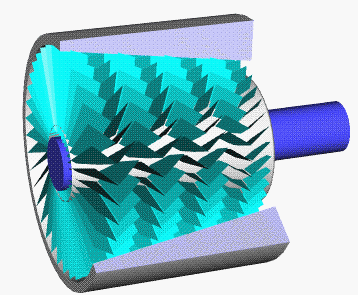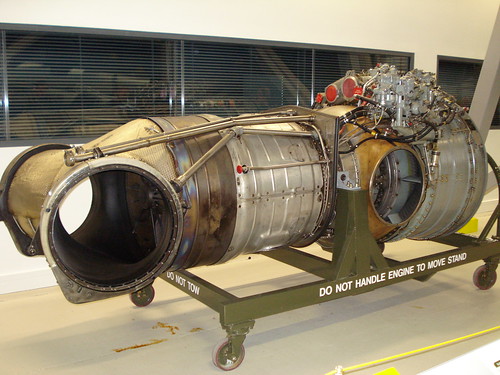KC135DELTA
Well-Known Member
- Joined
- Aug 1, 2006
- Messages
- 112
Ok, I understand this idea is far fetched so please don't make me out to be some psychopath - humor me here.
In the search for a highspeed vtol aircraft what is wrong with a faux-harrier two place VTOL aircraft powered by an axial-compressor instead of a turbofan? It operates under the same principles as a turbofan only instead using a piston or preferably aero diesel (high torque) as the power shaft. Counter rotation would be too complex (as if the who idea isn't already) so fixed stators just as in a jet engine would be simple enough to add stability to the shaft and add pressure while correcting the whirl-wing like tendency of the airflow compressed by an axial compressor.

looking at the harrier engine, it is complexly designed to equalized the high speed high pressure exhaust of the turbine (not an efficient power converter) and the low speed low pressure bypass exhaust (far more efficient)

This would be far more simple with an axial compressor as the entire pressurized contained body will always equalize itself and have equal thrust from each of the vtol pillars assuming identical nozzles are in place. This is illustrated via a MAN marine diesel turbocharger. The only difference being we would have four exhaust nozzles as opposed to two.

From what I understand roughly 7lbf of force is obtainable out of 1hp. So a compressor supplied with 300hp could produce 2,100lbf at sea level making an ~1,800lb vtol aircraft possible assuming some losses. Power loss at alititude would set on much quicker than a regular piston powered aircraft requiring a turbo-normalized engine and potentially variable blade pitch but even then hovering above 5,000ft asl is unlikely.
What does the hive think?
In the search for a highspeed vtol aircraft what is wrong with a faux-harrier two place VTOL aircraft powered by an axial-compressor instead of a turbofan? It operates under the same principles as a turbofan only instead using a piston or preferably aero diesel (high torque) as the power shaft. Counter rotation would be too complex (as if the who idea isn't already) so fixed stators just as in a jet engine would be simple enough to add stability to the shaft and add pressure while correcting the whirl-wing like tendency of the airflow compressed by an axial compressor.

looking at the harrier engine, it is complexly designed to equalized the high speed high pressure exhaust of the turbine (not an efficient power converter) and the low speed low pressure bypass exhaust (far more efficient)

This would be far more simple with an axial compressor as the entire pressurized contained body will always equalize itself and have equal thrust from each of the vtol pillars assuming identical nozzles are in place. This is illustrated via a MAN marine diesel turbocharger. The only difference being we would have four exhaust nozzles as opposed to two.

From what I understand roughly 7lbf of force is obtainable out of 1hp. So a compressor supplied with 300hp could produce 2,100lbf at sea level making an ~1,800lb vtol aircraft possible assuming some losses. Power loss at alititude would set on much quicker than a regular piston powered aircraft requiring a turbo-normalized engine and potentially variable blade pitch but even then hovering above 5,000ft asl is unlikely.
What does the hive think?



